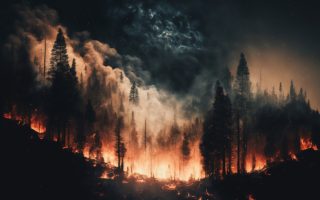
Summer is a time to enjoy your favorite outdoors activities: camping, swimming and barbecuing. As children leave school and adults readily finalize vacation plans, anticipation of what comes with summer heats up as the temperature rises. However, with summer also comes the prime conditions for wildfires across the globe. This summer we are experiencing extreme smoke pollution due to wildfires that are crossing the Canadian-US border.
As people are instructed to stay indoors and planes are grounded, the excitement of the season has been greatly tarnished, especially within the North East of the United States. Hazardous smoke is infiltrating the region and affecting even healthy people within it. Keep reading for insight into what the contaminated haze is composed of, how the plummet in air-quality can impact overall health and what you can do to stay healthy.
What Is Fire Smoke?
The smoke that is released into the air as wildfires burn is composed of gases and fine particles. These small fragments of combusted trees and shrubs range in size, and anything that can be picked up by wind and gas is incorporated into the smoke. The particles that are of greatest concern are those classified as PM2.5; this means the particulate matter is 2.5 microns or smaller. This size of debris can get stuck in the lungs and cause irritation, asthma, and in extreme cases heart attacks and strokes.
The gas from fire smoke that causes the greatest concern is carbon monoxide. This is a colorless, odorless gas that inhibits oxygen distribution in your tissues causing headaches, dizziness and nausea. Other chemicals and gases play a role in the smoke’s toxicity: nitrogen oxide and other volatile organic compounds are also present in the mix. This rainless storm that dominates the skies when it is unleashed is filled with contaminants that will negatively impact even those without underlying health concerns. Here’s what the US Department of Agriculture has to share about fire smoke.
It is Really That Bad?
Sitting around the campfire always brings great memories of s’mores and songs, could breathing in smoke from fires really be detrimental? In brief, yes! The physiological effects of interactions with smoke are profound, especially when inhaled. Many of the chemicals in the polluted vapor are carcinogens, exposure to which increases the likelihood of cancer, especially within the lungs. Over just short-term exposure, coughing and runny nose will occur to expel pollutants along with irritation to the eyes, throat and sinuses, causing discomfort. The respiratory impacts are vast, with difficulty breathing such as wheezing and shortness of breath, development of bronchitis, exacerbating asthma and worsened lung disease.
With prolonged exposure it is common to experience chest pain, headache, asthma attacks, fatigue and rapid heart rate. Those who are at greatest risk are the elderly, children, pregnant women and those with chronic heart or respiratory issues. This population is extremely susceptible and will respond with more adverse symptoms upon interaction with smoke. However, across the board, exposure to PM 2.5 and gaseous components of smoke will lead to transient reduction in pulmonary function.
How to Stay Healthy
Although breathing in smoke is a great risk there are tremendous resources to reduce exposure to this danger. Such as, wearing masks and investing in an air purifying unit. The best option is to remain indoors (with windows and doors shut) while running an air purifier system. Avoiding participation in strenuous physical activity is beneficial.
Unfortunately, while smoky skies are prevalent, this is no time for cardiovascular exercise. An increase of breathing and heart rate will increase inhalation of smoke, along with its negative side-effects. When traveling outdoors wearing a mask will help prevent fine particles from entering your airways. So, get some extra use out of the N95 mask you have laying around, from back in the pandemic days!
With the twofold threat of fine particles and gaseous contaminants, air purifying systems with multiple cleaning stages are best. HEPA filters would capture particles, while carbon filters would adsorb the acrid odors and gases. If you don’t know where to begin looking for your ideal air purifier, we have a few recommendations for you listed below:
- A wonderful unit for industrial smoke purification is the Amaircare 4000 VOC with HEPA and Carbon Canister Air Wash Filtration System. This heavy duty system covers 18,000 ft3 and targets particulate matter along with gases such as VOCs and odors. It uses a 16” HEPA filter and a second filter with 7 lbs of carbon.
- Another powerful unit, great for the home or office is the Austin Air HealthMate Plus HEPA Air Purifier. With a 4 stage air filtration system, covering 1500 sq feet, it efficiently filters gas. And is perfect for the average household within a smoke affected region.
- The Airpura UV614 is a safe option for those with compromised immune systems. It has a UV germicidal lamp that sterilizes antigens, pathogens and mold spores! Along with, HEPA filters that trap particles as small as 0.1 microns and 18 lbs of carbon. Effective up to 2000 sq ft, this is a great unit for those who are extremely susceptible to the negative side effects of breathing smoke.
The smoke that is produced with wildfires in these dry summer months is alarming. Not only has it hindered summer vacation plans but the quality of the lives of people in affected regions. Wildfire smoke, with its fine particles and harmful gases, poses a health threat. The respiratory function of all who breathe smoke, even in short exposures, will experience irritation and decreased performance. Remember to protect your airways by wearing masks outside and keep your lungs healthy with quality air purification systems indoors.
Tags: Bad Air Quality from Fires, Fire Smoke, How to Purify Air from Fries, Summer Fires Affects Air Quality, US Air Purifiers